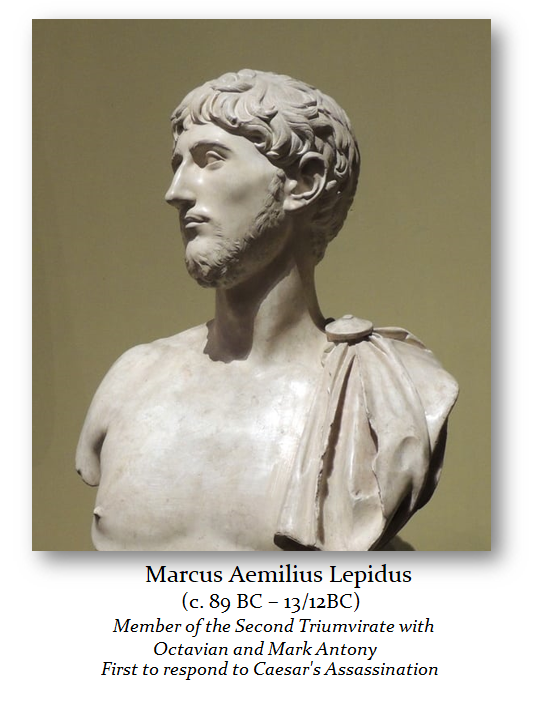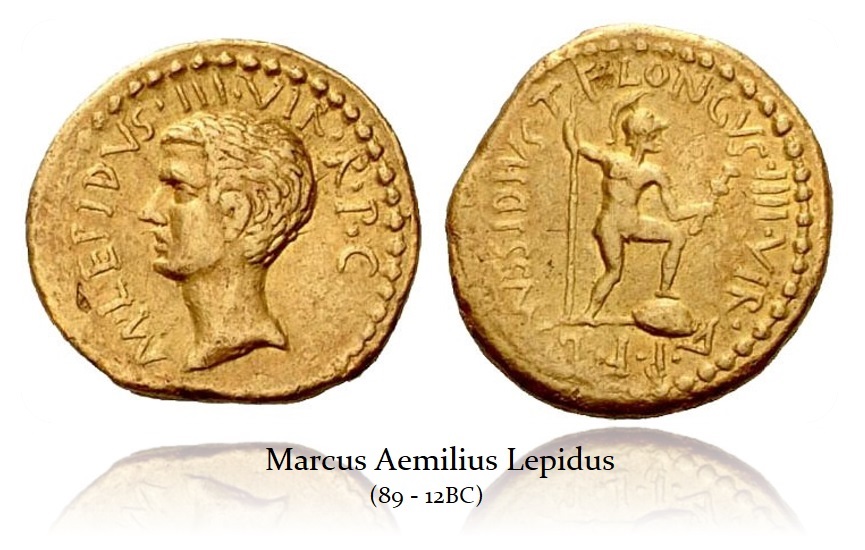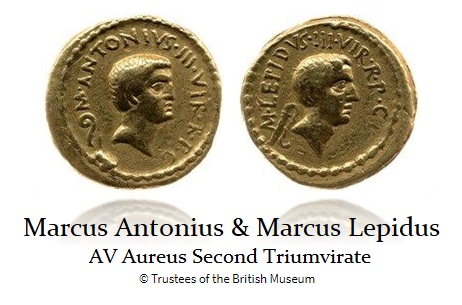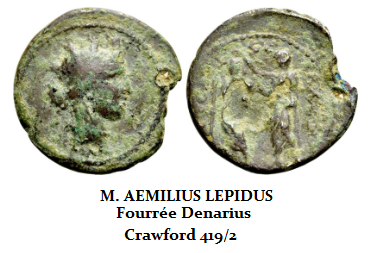Marcus Aemilius Lepidus
Junior partner in the Second Triumvirate
with Octavian and Marc Antony
died 13 BC
Marcus Aemilius Lepidus was the son of Marcus Aemilius Lepidus (c. 121 – 77 BC), who had been the consul of 78 BC. Lepidus used his family name and influence to his political benefit during the later days of the Republic. In 49 BC, he served as Praetor prior to joining Julius Caesar in the Civil War against the corrupt senate and Pompey the Great. As a reward for his support, Lepidus was given the consulship in 46 BC. In 44 BC, Lepidus was given the governorship of Gallia Narbonensis and Hispania Citerior. Following Caesar’s assassination on the Ides of March 44 BC, Lepidus emerged as one of the most feared men in Roman politics.
Lepidus was apparently near Rome at the time of the assassination. He immediately allied himself with Marc Antony, helping to stabilize the city in the chaos that followed. With the aid of Marc Antony, Lepidus assumed the office of Pontifex Maximus, which had previously been held by Julius Caesar.

2nd Triumvirate (Antony-Octavian-Lepidus)
In the early days of the Civil War, Marc Antony initially suffered a defeat at the Battle of Mutina. Antony fled to Lepidus, and the two gathered together all available legions and marched on Rome. On their way, they were met by Octavian (AUGUSTUS) in northern Italy. It was at that time that the three men formed the Second Triumvirate in October of 43 BC. The Roman world was divided among them, and Lepidus retained control of Gallia Narbonensis and Hispania Citerior but also gained Hispania Ulterior. Lepidus then held a second consulship in 42 BC.
Despite these political gains, Lepidus remained very much the junior partner. The true power resided in the hands of Antony and Octavian. Following the Battle of Philippi in 42 BC, a new separation of territories was reached. Lepidus lost his European possessions and was granted only Africa in its place. He held these territories until the year 36 BC.
Sextus Pompey, the pirate son of Pompey, was causing havoc on the high seas. In 36 BC, Octavian called upon Lepidus to bring reinforcements to Italy. Lepidus arrived in Sicily with 14 legions and helped to negotiate the surrender of Sextus Pompey’s army. Lepidus was never quite satisfied with his second-rate status to Octavian. With his large force now on Octavian’s doorstep, Lepidus made an attempt to wipe out Octavian. The attempt may have been gallant, but the end result was an easy victory for Octavian. Lepidus was stripped of all his titles with the exception of Pontifex Maximus. Lepidus then was forced to retire to his estate at Circeii. Octavian, who may have disliked Lepidus, continued to treat his old partner harshly. Lepidus‘ son, Marcus Aemilius Lepidus (III), attempted unsuccessfully to murder Octavian in 30 BC. Lepidus Junior was the first would-be assassin of an emperor, and the incident only gave Augustus another reason to torment his old partner. Finally, Lepidus died in 13 BC, and Octavian assumed his final title as Pontifex Maximus.
Monetary System

Lepidus with Octavian Denarius
Mints: Rome
Obverse Legends:
M LEPIDVS III VIR RPC
M LEPID IMP
LEPIDVS PONT MAX III VRPC
DENOMINATIONS
AU Aureus (Hd Lepidus rt/Vestal stg lf)
AU Aureus (Hd Lepidus rt/Female stg facing)
AU Aureus (Hd Lepidus rt/Mars stg rt helmet)
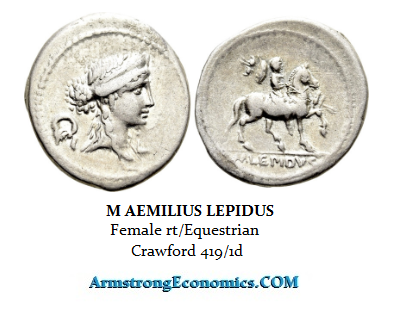
AR Denarius (Female hd rt/Horseman)
AR Denarius (Female hd rt/Togate PONF MAX)
AR Denarius (Female hd rt/Basilica Aemilia)
AR Quinarius
AU Aureus – with Octavian (6.54 grams)
AR Denarius – with Octavian
AU Aureus – with Marc Antony (6.54 grams)
AR Denarius – with Marc Antony
CONTEMPORARY COUNTERFEIT
AR Denarius – Fourree

